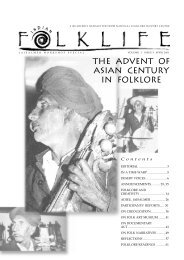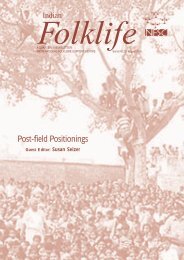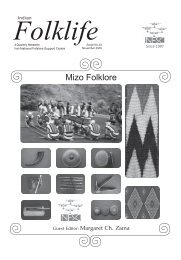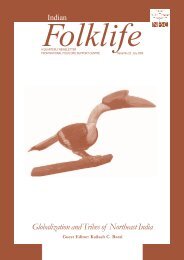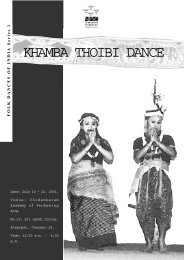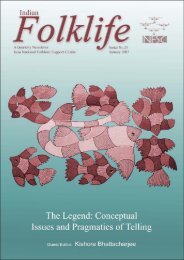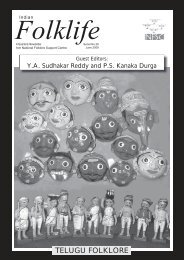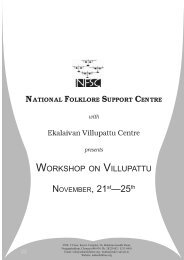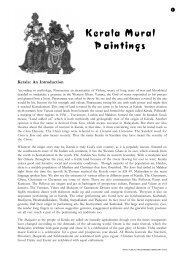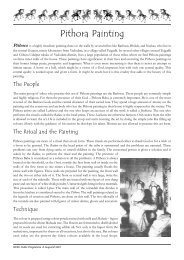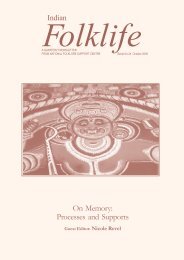Bamboo Flowering in the North-East - Wiki - National Folklore ...
Bamboo Flowering in the North-East - Wiki - National Folklore ...
Bamboo Flowering in the North-East - Wiki - National Folklore ...
Create successful ePaper yourself
Turn your PDF publications into a flip-book with our unique Google optimized e-Paper software.
Courtesy: http://rosswarner.comregards himself as a Sukuma or not, accord<strong>in</strong>g to <strong>the</strong>advantages of trac<strong>in</strong>g patril<strong>in</strong>eal, matril<strong>in</strong>eal or aff<strong>in</strong>alconnections or just <strong>in</strong>vent<strong>in</strong>g an ancestral one.These people do not appear to have any concept ofhome o<strong>the</strong>r than a vague sense of ancestralneighbourhood because <strong>the</strong>y have regularly moved tocope with field fertility and <strong>the</strong> needs of <strong>the</strong>ir cattle aswell as <strong>the</strong> sensible pattern of dispers<strong>in</strong>g <strong>the</strong>ir herdsand rotat<strong>in</strong>g <strong>the</strong>ir crops.In <strong>the</strong> 1950s, a Sukuma customary law manual wasproduced (Cory 1953) which showed that <strong>the</strong>y had asense of tribal identity but <strong>in</strong> practice such a book createda system of law ra<strong>the</strong>r than Sukuma custom throughwhich each case was settled accord<strong>in</strong>g to particular localcircumstancesThe Sukuma cultureOld Maasai woman with her grandchildThis has none of <strong>the</strong> obvious material elements thatcontribute so much to tribal identifications such asthat of <strong>the</strong> Kach<strong>in</strong>s and many o<strong>the</strong>r rich Asian cultures.They do not look different nor make any efforts to doso and <strong>the</strong> small facial mark<strong>in</strong>gs that used to denotesocial group affiliations such as <strong>the</strong> Bugika and Bugaruare no longer made. They have no material art and <strong>the</strong>zigzag mark<strong>in</strong>gs on <strong>the</strong>ir woven baskets are probablynow only to be seen <strong>in</strong> ethnographic collections. Theyclaim no tribal connection with <strong>the</strong> crude rock pa<strong>in</strong>t<strong>in</strong>gand lithographic designs that are to be seen on manyrock faces.What is perhaps extraord<strong>in</strong>ary is that if one can setaside that <strong>the</strong>y are an <strong>East</strong> African people, <strong>the</strong>ir socialcharacteristics and culture are remarkably similar tothat of contemporary Europeans. Their attention tok<strong>in</strong>ship is m<strong>in</strong>imal as most families are well dispersedand <strong>the</strong>ir social life is conf<strong>in</strong>ed to neighbourhoods andnetworks of reciprocities. Indeed, <strong>the</strong>y mistrust anyform of authority that is not subject to reciprocalcontrols and <strong>the</strong>y have yet to see any value <strong>in</strong> macrodemocraticsystems of vot<strong>in</strong>g.They have no regular religious rituals o<strong>the</strong>r than <strong>the</strong>wear<strong>in</strong>g of amulets and a variety of personal taboos.Despite <strong>the</strong> presence of Muslim traders and Christianmissionaries for well over a century, only smallnumbers have jo<strong>in</strong>ed <strong>the</strong>se faiths. They have no tribal<strong>in</strong>itiation rituals but <strong>the</strong>ir cross-community associationsdo let <strong>the</strong>m demonstrate <strong>the</strong>ir exclusivities. Thecostume of men is almost entirely of western designwhile <strong>the</strong>ir women comb<strong>in</strong>e <strong>the</strong> former with duallengths of highly coloured cloth of Swahili orig<strong>in</strong> from<strong>the</strong> coast.They do not wish to live near anyone else if it can beavoided, although <strong>the</strong>y did once live <strong>in</strong> closecommunities as a defence aga<strong>in</strong>st Maasai raid<strong>in</strong>g. Theirlives are very much based on quite accurate profit andloss balances <strong>in</strong> which it is sensible to live near <strong>the</strong>irfields. They do not see any particular value to liv<strong>in</strong>g <strong>in</strong>towns where food has to be paid for and prefer tocome and go from <strong>the</strong>ir rural homes.This is not to suggest that <strong>the</strong>y do not have a culturalidentity, which is now more prom<strong>in</strong>ent than it was <strong>in</strong>colonial times. Their tribal museum and cultural centreat Bujora near Mwanza is a matter of pride. It is hardto see <strong>in</strong> what ways <strong>the</strong>re is a Sukuma culture s<strong>in</strong>ce somuch is shared with surround<strong>in</strong>g tribal communitiesexcept possibly <strong>in</strong> <strong>the</strong>ir language with its complicatedtenses and its song and poetic forms. In <strong>the</strong> historicpast, <strong>the</strong>re may not have been any corporate tribalidentity but it has been created, without overmuchtension, by <strong>the</strong> makers of adm<strong>in</strong>istrative boundariesand by <strong>the</strong> rituals of vot<strong>in</strong>g. At <strong>the</strong> crudely materiallevel, <strong>the</strong>y are no different to millions of o<strong>the</strong>rs <strong>in</strong>eastern Africa.Some reflections on <strong>the</strong> nature of tribal culturesModern governments of large states like tribal cultureswhile be<strong>in</strong>g hostile to tribalism. Tribal costumes are tobe seen worn by cont<strong>in</strong>gents <strong>in</strong> Myanmar and Indiannational day parades, and representatives wear <strong>the</strong>irtribal costumes <strong>in</strong> meet<strong>in</strong>gs of <strong>the</strong> national assemblyof <strong>the</strong> Ch<strong>in</strong>ese Communist Party. The British Queen’srecent jubilee celebrations showed many forms ofBritish and Commonwealth tribal cultures <strong>in</strong> <strong>the</strong>irmodernised forms. Tribal costumes frequently appearon national stamps and <strong>in</strong> musical groups. To someextent, <strong>the</strong> Indonesian government subsidises andsupports <strong>the</strong> flamboyant public celebrations of Bal<strong>in</strong>eseH<strong>in</strong>duism that br<strong>in</strong>gs <strong>in</strong> much tourist money. At <strong>the</strong>same time, governments suppress demands for tribal<strong>in</strong>dependence <strong>in</strong> West Irian and Assam. So, tribalcultures testify to <strong>the</strong> range of national citizenship andliberalism; <strong>the</strong>y are a modern, political ‘good’ and thusare often subsidised unless <strong>the</strong>y go too far and claimseparation.20 INDIAN FOLKLIFE VOLUME 2 ISSUE 3 JANUARY - MARCH 2003



